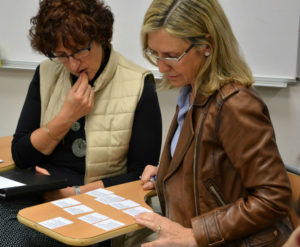Concept Based Planning
In-house teacher training
This course is also available online
1 week
Course Length
Flexible
Lesson Days
15
Lessons
English
Language
B1
Minimum Level
Overview
Our course concept based planning will bring you to use your subject’s ‘big ideas’, or ‘powerful knowledge’ to drive the lesson, rather than focusing on specific and separate pieces of information, knowledge, or tasks.
This teacher training will let you understand how to integrate different lessons by giving students a more coherent experience, after this course, you will be able to help your students to journey deeper into your subject by leading students to consider the context in which they are going to use their understanding.
After this course, you will be able to bring content knowledge and skills to “real world” meaning. You will get a deeper knowledge of how to let the students become critical thinkers and how to develop your students’ ability to creatively solve problems in the 21st century.
You will lead your students to think about content and facts by bringing them to understand how they can transfer their knowledge between personal experiences, learning from other disciplines, and the broader global community, and this, by using teaching and learning techniques that are driven by overarching concepts.
Completing this course will help you:
- Create connections to students’ prior experience
- Bring relevance to student learning
- Facilitate deeper understanding of content knowledge
- Act as a springboard for students to respond to their learning with action.
Who is the course for?
For teachers who want to acquire knowledge of universal themes by engaging them in active learning concept-based instruction.
Course Sample programme
| Week 1 | Course Content |
| Day One | Integrate different lessons by giving students a more coherent experience |
| Day Two | Content knowledge and skills |
| Day Three | How to let the students become critical thinkers |
| Day Four | Lead your students to think about content and facts |
| Day Five | Process Review and Feedback |
*Please note that the course content may be subject to change due to latest methodology trends updates. 1 lesson=45mins
Share This Class:
What people are saying



In-House Training
You might also be interested in these courses

Supporting pupils with Special Educational Needs and Disabilities
This course develops the skills of those involved in the education of pupils with Special Educational Needs and/or Disabilities (SEND) so that these children…

Higher Order Thinking
Developing Higher Order Thinking requires teachers to establish with their student a knowledge base of thinking skills, reasoning, critical thought, and problem-solving…

Scaffolding
With our workshop “Scaffolding” you will understand in more details on how to support second language learners by providing helpful hints to help students…
More Courses in the UK, Ireland and Malta
You might also be interested in these courses

Technology for Language Teachers
Technology for Language teachers is aimed at teachers who want to use more technology in the classroom to enhance the learning experience of their students…

Teaching for Exam Classes
Teaching for Exam Classes is for English teachers who are preparing teenage or adult students for exams. Preparing to teach Cambridge or IELTS exam class. London…

Pronunciation and Performance with an expert “Adrian Underhill”
Pronunciation and Performance with an expert is a course led by a world-renowned ELT Consultant and Trainer. Adrian Underhill is an author and the series…
Methodologies

Total Physical Response
Total Physical Response is considered to be an excellent way of learning vocabulary. Moreover, since it is based on commands, the students can easily learn the meaning of the words in the target language.

The Structural Approach
This method is based on the opinion that it is imperative to understand the structures of the language. Understanding the complexities of the structures of the sentences in a language is more important than learning the vocabulary of the language.

The Direct Method
This method primarily focuses on the development of oral skills. One of the most important characteristic feature of this method is that visual materials and real-life objects are used. Moreover, such an oral training helps in reading and writing. There is no translation involved in this method.
